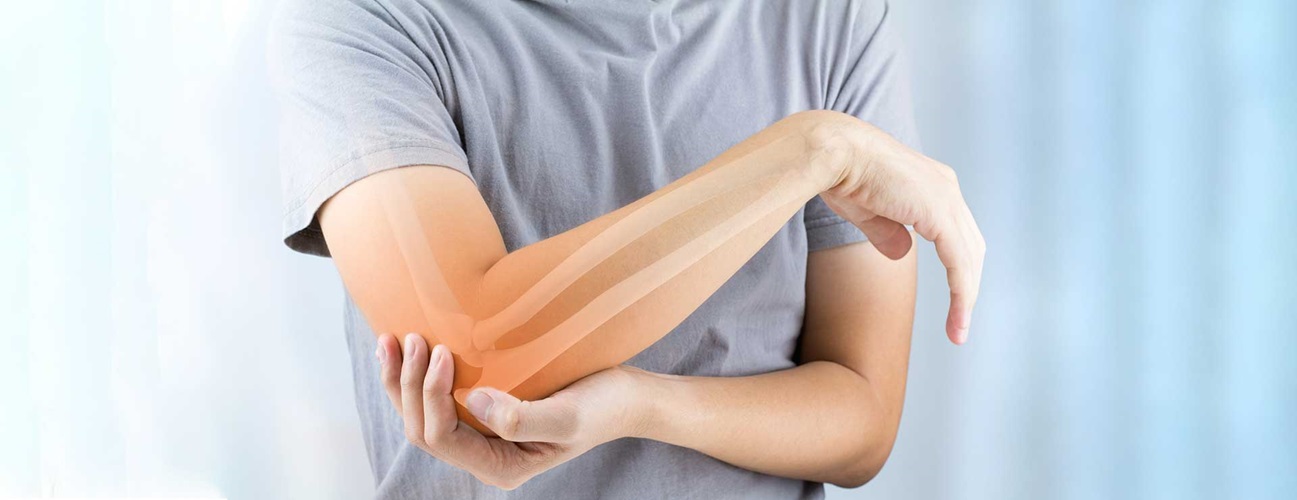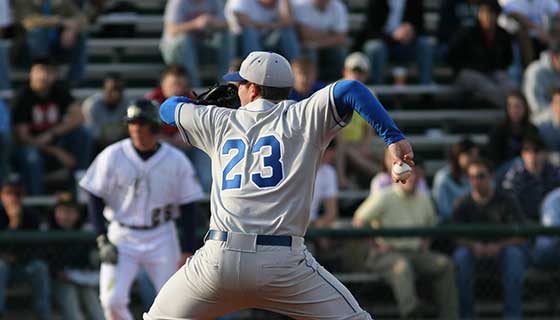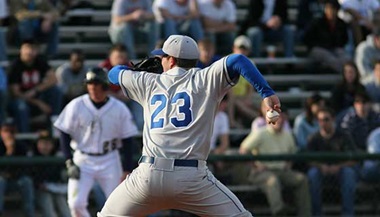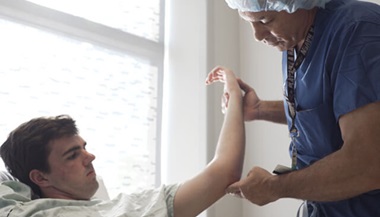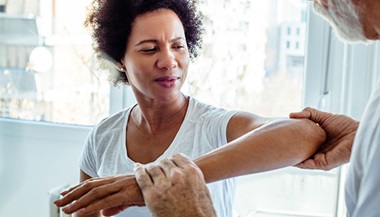Ulnar Collateral Ligament (UCL) Injuries of the Elbow
What You Need to Know
- The most common UCL injury is a UCL tear that is usually gradual but may also happen in a single traumatic event.
- Pain on the inner side of the elbow is the most common symptom of a UCL injury. A UCL tear may sometimes feel like a “pop” after throwing followed by intense pain.
- UCL injuries are diagnosed by physical examination and a valgus stress test to assess instability of the elbow. An MRI scan or may also be taken.
- Treatment for UCL injuries ranges from rest and physical therapy to surgery, depending on the extent of the UCL tear and your health goals.
What is the ulnar collateral ligament?
Ligaments are strong bands of tissue that hold bones together and help control the movement of joints. A ligament serves as a tether between the bones. When the ligament is torn, the tether is too long and the bones move too much. This can lead to pain, a sense of instability or looseness, and an inability to work or play sports.
The ulnar collateral ligament complex is located on the inside of the elbow (pinky or medial side). It is attached on one side to the humerus (the bone of the upper arm) and on the other side to the ulna (a bone in the forearm). A UCL consists of three bands or divisions: the anterior (front), posterior (back) and transverse (across) bands. The anterior band is the most important for the elbow’s stability of the elbow.
How do UCL injuries happen?
UCL Tears From Overuse
The UCL can be injured in several ways. Most commonly, there is a gradual onset of elbow pain due to repetitive stresses on the ligament. This is especially common in athletes who play sports that require overhead arm use or throwing.
UCL Injuries in Children
Children, particularly baseball pitchers under age 15, may develop UCL tears from repeated stress. It is important to remember that pain when throwing is not normal for young children. It should be addressed immediately to prevent further injury.
A UCL tear shouldn’t be confused with Little League elbow — another overuse injury common in young baseball players. This is an injury to the growth plates on the ends of the bones forming the elbow joint.
10 Tips for Preventing Sports Injuries in Kids and Teens

Young athletes today push themselves harder than ever before, which means they’re at greater risk for sports-related injuries. Pediatric sports medicine expert R. Jay Lee provides these 10 injury prevention tips to help keep your young athlete safe.
Traumatic UCL Injuries
The ulnar collateral ligament may also be injured if you fall on your outstretched arm. In this case, the UCL may rupture or get pulled off the humerus, chipping a small piece of bone. This is called an avulsion fracture, and it’s rare. This type of trauma is sometimes accompanied by elbow dislocation or elbow fracture.
What are the symptoms of a UCL injury?
- A sudden “pop” or pain along the inside of the elbow, leading to the inability to continue throwing.
- Pain on the inside of the elbow after a period of heavy throwing or other overhead activity.
- Pain when accelerating the arm forward, just prior to releasing a ball.
- Tingling or numbness in the pinky and ring fingers.
The instability resulting from a UCL tear may affect your ability to participate in sports that require throwing. However, it is unlikely to affect your daily living activities, such as carrying a bag of groceries. A UCL tear rarely prevents people from exercising, lifting weights, running or performing other nonthrowing activities.
Elbow Surgery | Michael's Story
College athlete Michael Perry was a young and healthy offensive lineman until he was knocked over on his elbow after practice. He immediately knew something was wrong. Johns Hopkins elbow specialists diagnosed Michael and discovered how serious his injury was.
How are UCL injuries diagnosed?
Diagnosis is often more difficult than the treatment of a UCL injury. These types of injuries are typically diagnosed and treated by an orthopaedic specialist or a sports medicine expert. A UCL tear can be diagnosed through a history and physical examination. A valgus stress test, during which a physician tests your elbow for instability, is the best way to assess the condition of the UCL.
An MRI scan and X-ray may also be used to see the changes in the ulnar collateral ligament related to stress. However, these tests are rarely used as the sole basis for a diagnosis. Although an MRI scan may show a UCL tear, it may not be 100 percent accurate. Injecting dye (gadolinium) into the joint before the MRI sometimes increases its accuracy.
How are UCL injuries treated?
The treatment options for a UCL injury depend on your goals. If you want to return to strenuous overhead or throwing activities and nonoperative treatments didn’t help, then your doctor might recommend surgical repair of the torn UCL.
Nonsurgical UCL Treatment
This approach aims to stabilize the elbow and offer pain relief. It may include:
- Initial period of rest.
- Nonsteroidal anti-inflammatory medications such as aspirin, ibuprofen, naproxen, etc.
- Applying ice to the elbow daily until the pain and swelling are gone.
- After inflammation has decreased, you may begin physical therapy to strengthen the muscles around the elbow to compensate for the torn ligament.
UCL Reconstruction (Tommy John Surgery)
Tommy John Surgery uses a tendon taken from somewhere else in the body, or from a donor, to serve as the new UCL. Tunnels are drilled in the ulna and humerus to secure the new tendon (graft). Remnants of the original ligament may be attached to the graft to strengthen it.
How long does recovery after a UCL injury take?
If your UCL tear can be treated without surgery, the recovery may last anywhere from several weeks to several months. It depends on the range of motion you’d like to achieve in the elbow. Your physician and physical therapist will work together to monitor your progress.
If Tommy John Surgery is recommended, the rehabilitation can take nine months to a year, and sometimes longer. Your elbow will be placed in a hinged brace to gradually increase the range of motion until you can fully extend it. If you plan to return to throwing and compete, you will need physical therapy that is more rigorous to strengthen your elbow enough to handle the stress. Everyone recovers at a different speed, but the return to your sport should never be rushed. Too much stress on the graft before it has healed increases the risk of failure.

